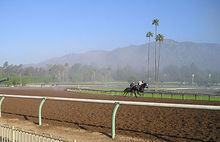While no regulatory change are proposed at this time by the California Horse Racing Medication and Track Safety Committee, it appears there is a national movement towards regulating corticosteroid use and particularly, intra-articular corticosteroid use.

Horse racing at Santa Anita
While no regulatory changes are proposed at this time by the California Horse Racing Medication and Track Safety Committee, it appears there is a national movement towards regulating corticosteroid use.
The Racing Medication and Testing Consortium (RMTC) has recommended a 7 day prohibition of intra-articular injections prior to racing. New York already had an unforced 5 day prohibition for intra-muscular injections.
Governor Cuomo's Racing Task Force recommended a 14 day prohibition for methyl prednisolone· acetate (Depo-Medrol®) and a 7 day prohibition for all others. Currently, most corticosteroids are Class 4 drugs with Category C penalties.
The RMTC recently approved minimum withdrawal time recommendations for corticosteroids. These recommendations were based on recently completed work funded in-part by RMTC conducted at the University of Pennsylvania, University of California-Davis Kenneth L. Maddy Laboratory, HFL Laboratory-Kentucky and other corticosteroid research conducted both in the U.S. and abroad.
The recommendations were developed during an RMTC hosted Corticosteroid Experts Conference in Anaheim, California on November 30. The meeting brought together qualified individuals with professional expertise in key areas with the goal of providing a comprehensive plan for regulating corticosteroid use in horse racing to protect equine health and welfare.
The Racing Medication and Testing Consortium determined thresholds for 3 additional corticosteroids based upon the recommendations that were made at the Corticosteroid Expert Conference in Anaheim. The RMTC defines threshold as the maximum concentration of a therapeutic substance that, when detected in a post-race sample, does not constitute a violation.
Concentrations above this level will be treated as a violation. These thresholds were approved by the RMTC Executive Committee pursuant to the board's action at the November 2012 meeting.
The following recommendations were sent to the ARCI:
The Corticosteroid Expert Conference participants recommended a blanket 7 day withdrawal time on all intra-articular corticosteroids. For all corticosteroids, 7 days is the minimum time period that must elapse between any intra-articular corticosteroid treatment and the time of racing. In addition, the participants recommended thresholds based upon completed research where it exists.
The recommended thresholds for each corticosteroid follow:
• Betamethasone - the recommended regulatory threshold for betamethasone is 10 picogram (pg) per mL of plasma. This is based upon a single 9 mg intra-muscular administration of betamethasone in a mixture of betamethasone sodium phosphate and . betamethasone acetate. This combination is the common formulation for clinical use. For plasma concentrations to be below the plasma threshold following a single intra-articular administration of this dose of betamethasone, the injection must be completed at least 7 days prior to racing. Intramusculm· administration, administration exceeding this dose, repeated doses by any route or combination of routes, or doses into more than one articular space will probably require additional time for betamethasone concentrations to fall below the recommended regulatory threshold.
• Triamcinolone acetonide - the recommended regulatory threshold for triamcinolone acetonide is 1 00 pg/mL of plasma. This is based upon a single 9 mg intra-articular administration of triamcinolone acetonide. For plasma concentrations to be below the plasma threshold following a single intra-atiicular administration of this dose of triamcinolone acetonide, the injection must be completed at least 7 days prior to racing. Intraniuscular administration, administration exceeding this dose, repeated doses by any route or combination of routes, or doses into more than one atiicular space will probably require additional time to fall below the recommended regulatory threshold.
• Methylprednisolone - the recommended regulatory threshold for methylprednisolone is 1 00 pg/mL of plasma. This is based upon a single 100 mg intra-articulm· administration of methylprednisolone acetate. For plasma concentrations to be below the plasma threshold following a single intra-ari icular administration of this dose of methylprednisolone acetate, the injection should be completed not less than 21 days prior to racing. Intranmsucular administration, administration exceeding this dose, repeated doses or doses into more than one articular· space will require additional time to fall below the recommended regulatory threshold. Intra-articular administrations at a dose smaller than this may require less than 21 days for plasma concentrations to fall below the reconmended regulatory threshold. However, the 7 day overall ban on intra-articular administration should remain as a floor for this medication regardless of the size of dose administered intra-articularly,
Please note - these withdrawal times are based solely on intra-muscular injection. The experimental data from intramuscular administration shows that the corticosteroids are readily detectable for extended periods of time after administration of the long-acting corticosteroid formulations such as the suspensions and acetate ester formulations.
In the completed studies, intra-muscular· administration significantly extended the time required for the drug concentration to fall below the laboratory threshold. For example, betamethasone concentrations did not fall below the 10 pg/mL threshold for 33 days after intramuscular administration.
Because practitioners vary in the amount and way that they utilize these long-acting corticosteroids, we cannot provide definitive withdrawal guidance for every dosage and every protocol. Therefore, we are also recommending that the model rule include a grace period until January 1, 2014 to allow the racing industry to move forward uniformly.
